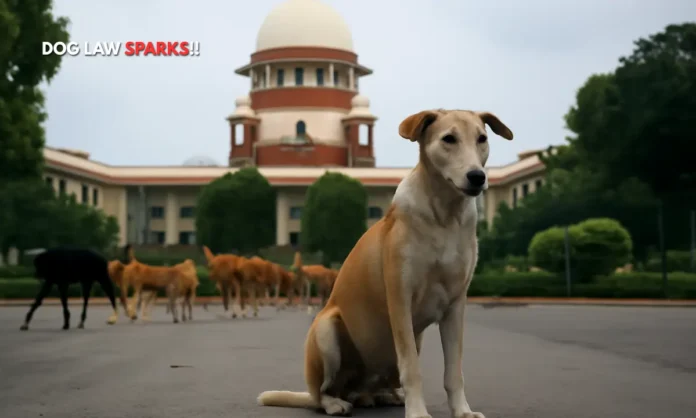Summary
- Supreme Court’s August 11, 2025 ruling directs relocation of all stray dogs in Delhi-NCR to shelters.
- Animal rights groups and activists, including Maneka Gandhi and PETA India, warn the move is logistically and scientifically unfeasible.
- Delhi government faces an infrastructure challenge, with estimates of up to 2,000 new centres required to accommodate community dogs.
Supreme Court Stray Dog Order Delhi: Unscientific?
The Supreme Court stray dog order Delhi has ignited one of the most heated public debates in recent memory over urban animal management and public safety. Issued on August 11, 2025, the ruling mandates the relocation of all stray dogs in Delhi-NCR to designated shelters, a measure the court framed as essential for controlling the rising number of dog bite incidents. While supporters argue that the move could significantly reduce public health risks, particularly rabies transmission, animal rights advocates are warning of severe unintended consequences.
The decision comes against a backdrop of troubling statistics. According to the Ministry of Health and Family Welfare, India recorded 3.7 million dog bite cases in 2024, with nearly 430,000 reported in January 2025 alone. Delhi alone is home to an estimated one million stray dogs, and relocating them all would require an unprecedented expansion of shelter infrastructure. The Supreme Court stray dog order Delhi has thus become more than just a legal directive; it is now a flashpoint for competing priorities of public safety, animal welfare, and administrative capacity.
This is the most ridiculous order! Stray dogs have right to live among communities-no Court can pass such a cruel order.However,'Rabid', dogs can be identified & segregated.All Stray Dogs In Delhi-NCR To Be Moved To Shelters: Supreme Court's Big Order https://t.co/0oi0ifgNZm
— Chandra Kumar Bose (@Chandrakbose) August 11, 2025
Main Narrative – Ruling and Immediate Impact
- The Supreme Court stray dog order Delhi stems from multiple petitions filed by residents’ welfare associations (RWAs) citing escalating dog bite cases.
- The directive requires municipal corporations to remove stray dogs from public spaces and place them in registered shelters until sterilisation and vaccination protocols are complete.
For RWAs, the ruling offers long-awaited relief. Residents in Dwarka, Janakpuri, and Lajpat Nagar have repeatedly voiced concerns over attacks near schools, parks, and marketplaces. Government data shows Delhi contributes significantly to India’s rabies burden, with many incidents concentrated in densely populated areas.
Despite the urgency, the Supreme Court stray dog order Delhi faces major operational hurdles. The Municipal Corporation of Delhi (MCD) acknowledges shelter capacity is limited to roughly 12,000 dogs — a fraction of the one million stray population. Expanding facilities to bridge this gap could cost hundreds of crores and take years to execute.
Emerging Insights – Activist and Expert Concerns
- Animal rights groups say the Supreme Court stray dog order Delhi conflicts with the Animal Birth Control (Dogs) Rules, 2023.
- They warn that large-scale removal could cause stress, disease, and disruption of community dog ecosystems.
PETA India’s senior director of veterinary affairs, Mini Aravindan, has labelled the relocation plan “unfeasible” and potentially inhumane. The group estimates that building shelters for even half of the stray population would require land the size of dozens of football fields.
Maneka Gandhi has argued that the MCD would need to identify up to 2,000 new centres to house the dogs, calling this financially and logistically impractical. In her assessment, the Supreme Court stray dog order Delhi risks undoing years of sterilisation and vaccination gains achieved in several wards.
Critical Analysis – Balancing Safety and Sustainability
- Experts caution the Supreme Court stray dog order Delhi prioritises immediate safety without a long-term plan.
- WHO guidelines recommend sterilisation, vaccination, and community involvement as humane, cost-effective strategies.
According to the Department of Animal Husbandry and Dairying (DAHD) under NAPRE 2030, achieving over 70% sterilisation in a given area can significantly reduce dog population growth and bite rates within three years.
Critics say mass sheltering could lead to overcrowding, which fosters the spread of parvovirus and distemper. Removing territorial dogs might also allow unvaccinated animals from other areas to enter, destabilising local ecosystems.
Supporters of the Supreme Court stray dog order Delhi argue that sterilisation campaigns have failed to match population growth and that public safety must take precedence. They cite cases involving fatalities among children and senior citizens to stress the urgency of the intervention.
Policy Pathways and Potential Outcomes
- The Supreme Court stray dog order Delhi could influence nationwide approaches to stray animal management.
- Delhi must balance safety, animal welfare, and resource constraints to avoid policy failure.
In the immediate term, the government will need to assess current shelter capacities, identify suitable land for expansion, and secure large-scale funding. Collaborations with NGOs, corporate CSR programmes, and global animal welfare organisations could speed up progress.
Long-term strategies may involve a hybrid model that integrates targeted sheltering with accelerated sterilisation and vaccination drives. Without such balance, experts warn bite rates could rebound once shelters reach capacity. The Supreme Court stray dog order Delhi could either become a model for humane management or a lesson in logistical miscalculation.
A Test of Policy Execution
The Supreme Court stray dog order Delhi is a bold judicial move into a complex public health and animal welfare issue. While it aims to protect human life, it exposes gaps in infrastructure, planning, and policy coherence.
If the city can craft evidence-based, humane, and financially viable solutions, the order could mark a turning point in urban stray management. If not, it risks becoming another high-profile directive bogged down by impracticality. The coming months will reveal whether this is the beginning of a sustainable model or a cautionary example for future governance.


